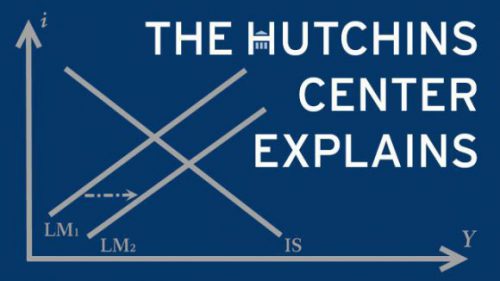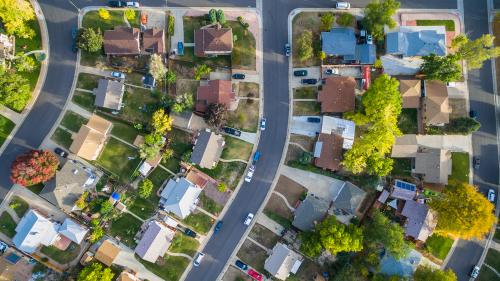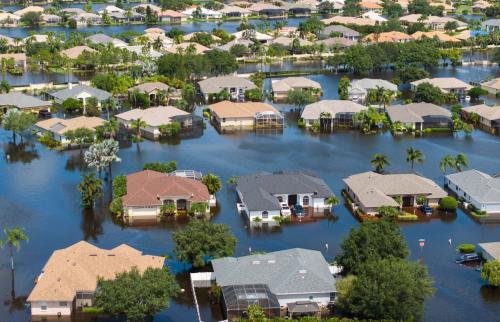In the early 2000s, the U.S. had an oversupply of houses, which led to the collapse of housing prices and triggered the Global Financial Crisis of 2007-9. But since then, the notion that the U.S. is currently suffering from a “housing shortage” has been widely accepted by politicians, the public, and the press. Housing costs are high on the worry list for many voters; hence candidates’ eagerness to offer solutions. Economists generally look at prices to gauge when demand is growing faster than supply, but this post focuses on headline-making estimates that try to quantify the shortage of housing. How are they calculated? How meaningful are they?
How are widely cited estimates of a housing shortage calculated?
The estimates of the housing shortage most often quoted in the press, by politicians and by White House economists, rely on vacancy rates—the number of vacant homes as a share of all housing units—as a key indicator. Government measures show the vacancy rate rising until 2010 and falling since. These estimates essentially see a vacancy rate lower than a historical norm as a sign of a housing shortage, which puts upward pressure on home prices and rents. This resembles the way economists compare the current unemployment rate to estimates of the unemployment rate that is consistent with stable inflation, the NAIRU, or Non-Accelerating Inflation Rate of Unemployment. (When the unemployment rate is below the NAIRU, idle workers are in short supply, and wages and prices tend to rise.)
The National Association of Home Builders’ (NAHB) compares vacancy rates in metro markets (so it doesn’t include rural or other communities) from the Census Bureau’s American Community Survey to “normal” vacancy rates based on the historical average between 2005, when the ACS began generating these data, and 2021. (Note that span includes the period preceding the Global Financial Crisis when the U.S. had a glut of houses.) NAHB notes that the “normal” vacancy rate can vary significantly across metro areas. Its estimate of the housing shortage is the increase in the number of vacant houses that would bring current vacancy rates back to these “normal” ones. NAHB does not count seasonal or second homes in its calculation of the current vacancy rate.
For example, in the Phoenix-Mesa-Chandler, AZ, metro area, the 2021 owner-occupied vacancy rate was 0.6%, the “normal” owner vacancy rate is 2.7%, and the current stock consists of 1,269,308 owner-occupied and vacant for-sale/sold units. Of these, 7,996 units were vacant and available for sale. If there were 27,565 more vacant for-sale housing units, the 2021 vacancy rate would have been 2.7%—the normal rate—and so the housing shortage in Phoenix according to this method is 27,565 for-sale units. On the rental side, in the Phoenix metro area, the 2021 rental vacancy rate was 4.3%, the “normal” rental vacancy rate is 8.5%, and the current stock consists of 648,230 rental units. Out of these, 27,817 units were vacant and available for rent. If there were 29,766 more vacant for-rent units, the vacancy rate would have returned to the normal rate. So the rental shortage in Phoenix according to this method is 29,766 units. And the total (rental plus owner-occupied) shortfall is 51,331.
Looking across all 290 metro areas, NAHB’s estimate of the 2021 American Community Survey finds the vacancy-rate among owner-occupied homes dropped below 0.9% and rental vacancy rates hit 5.2%, the lowest level recorded since the ACS began generating these data in 2005. The NAHB estimates that in metro areas with very low vacancy rates (that is, not counting communities with abnormally high vacancy rates), it would take 1.5 million units (800,000 rental and 750,000 for sale) to restore “long-run equilibrium.”
Freddie Mac’s estimate is much higher—3.8 million. From the Census Bureau’s quarterly Housing Vacancy Survey, Freddie Mac starts with 15.4 million vacant units (including seasonal or vacation units and units that are held off the market for a variety of reasons) which puts the national vacancy rate at year-end 2020 at 10.9% for both owner-occupied and rental properties [Excel download]. It compares that to its target vacancy rate of 13%—the level it says is necessary for a “well-functioning housing market”—and concludes that 3.5 million units are needed to raise the vacancy rate to that level. Most of the discrepancy between Freddie Mac’s numbers and NAHB’s concerns the treatment of housing units that are neither for sale nor occupied, which comprised about 8.3% of the housing stock in 2021, down from an average of 9.3% from 2005-2019. In addition, Freddie Mac also doesn’t distinguish between owner-occupied and rental housing and does a national estimate, instead of adding up estimates from individual markets.
Freddie Mac also adds to the vacancy-rate shortage estimate an approximation of the number of young people who would have moved to their own apartments or homes if they could have afforded to—about 400,000. That (with rounding) produces the 3.8 million estimate.
Mark Zandi, chief economist at Moody’s Analytics, also compares the current vacancy rate to his estimate of the equilibrium vacancy rate, which he defines as “the rate consistent with stable housing affordability wherein house prices and rents increase at the pace of household income.” He says that period from 1985 to 2000 fits that definition which produces an equilibrium vacancy rate at 1.6% for owner-occupied homes and 7.6% for rentals, which works out to an overall rate of 3%. With data for the second quarter of 2024 from the Census Bureau’s Residential Vacancies and Homeownership, adjusted to remove season and vacation homes and units classified by Census as “held off the market” for some reason, Zandi finds a shortfall of 1.1 million units (offsetting states with estimated shortages, or low vacancy rates, with those with estimates of oversupply, or high vacancy rates). To that he adds his estimate of people who are living with relatives or acquaintances because they can’t afford their own place, assuming historical headship trends were prevailing and adjusting for the recent surge in immigration—which adds up to 1.0 million. Then, in a novel adjustment, he adds 700,000 units as an estimate of the shortfall of affordable housing, approximately the bottom half of the housing market in terms of house prices and rents.
Zandi’s bottom line: The U.S. has a shortage of affordable housing of 2.8 million units. It’s an estimate that has influenced Vice President Kamala Harris, who proposes partnering with the private sector to build 3 million new homes over four years.
What are the pros and cons of the vacancy approach?
For builders, the vacancy rate in a particular market has obvious appeal: If there are a lot of vacant units, that market isn’t a great place to build new housing. For other analysts, just as the unemployment rate is low in a tight labor market, the vacancy rate is low in a tight housing market, as buyers grab houses as soon as they come on the market and as existing homeowners don’t move, knowing they won’t easily find another house. From this perspective, the vacancy rate might be a better measure of short-run dynamics in the housing cycle rather than useful for long-term trends. Vacancy rates over time may reflect slower-moving changes in demographics and technology. Vacancies could be declining over time for reasons unrelated to imbalances between supply and demand. For example, improvements in information technology could reduce the cost and time for matching buyers and sellers and renters and landlords, and changes in demographics, increases in homeownership, or declines in Americans’ tendency to move may mean that people stay in their homes longer, and so fewer houses go through the churn of changing occupants. Of course, using time periods in which home-building and vacancy rates were unusually high (such as the mid-2000s before the Great Recession) to calculate the long-run average can be misleading.
In addition, national averages obscure differences across housing markets. A glut of empty houses in, say, Detroit doesn’t offset a low level of vacancies in San Francisco. Several of the analyses break the data into metro areas or, as Zandi does, by Census tract. (He finds, for instance, that the entire shortfall of rental housing in Philadelphia County is in the lower-income neighborhoods west of downtown, a shortage obscured in county-level data because of more than ample housing in the wealthier neighborhoods closer to the central city.)
Other metrics attempt to measure the shortage of affordable housing by tracking the share of households who spend more than 30% and more than 50% of their income on housing and utilities, such as this post from Harvard’s Joint Center for Housing Studies.
What other approaches are used to estimate the housing shortage?
The National Association of Realtors commissioned a report in 2021 from Rosen Consulting Group, a real estate consultancy based in Berkeley, California, that didn’t use the vacancy rate method. It reported an “underbuilding gap” of at least 5.5 million housing units. Rosen compared the number of new housing units added in 2001-2020 (1.225 million/year) to the number of homes that would have been produced if the previous historical annual average construction rate for 1968-2000 (1.5 million/year) had held. Summing this difference across 20 years, it came up with a shortfall of 5.5 million units by 2020. This approach ignores the changing demographics over that period.
How much do zoning and other restrictions on building affect the housing market?
A lot. Instead of looking at vacancy rates (which compare housing supply relative to the demand for housing in the past), Kevin Corinth of the American Enterprise Institute and Hugo Dante of George Mason University compare the actual number of housing units (both single-family and multifamily) to the number that they estimate would have been built in the absence of zoning and other constraints. Using county-level data on the share of home prices that is attributed to the value of the land—and assuming that in markets without supply constraints, land would represent 20% of the price of a house—they put the housing shortfall at 20.1 million homes in 2021, or about 14% of the total national housing stock.
-
Acknowledgements and disclosures
The Brookings Institution is financed through the support of a diverse array of foundations, corporations, governments, individuals, as well as an endowment. A list of donors can be found in our annual reports published online here. The findings, interpretations, and conclusions in this report are solely those of its author(s) and are not influenced by any donation.
The Brookings Institution is committed to quality, independence, and impact.
We are supported by a diverse array of funders. In line with our values and policies, each Brookings publication represents the sole views of its author(s).








Commentary
Where do the estimates of a “housing shortage” come from?
October 21, 2024